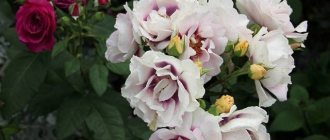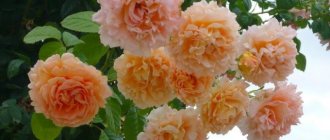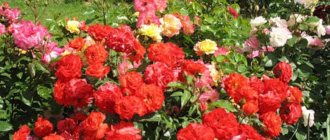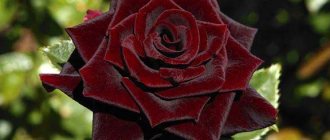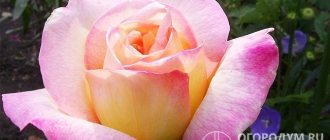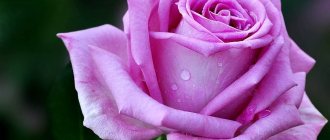Rose Leonardo da Vinci (Leonardo da Vinci rose or MEIdeauri) - what kind of variety is it, history of creation
The floribunda variety Leonardo da Vinci was developed in 1993. The flowers are bright pink, medium in size - no more than 12 cm in diameter, with a light tea aroma. The number of petals varies considerably (from 40 to 80). The leaves are dark green and shiny throughout the season due to disease resistance.
Rosa Leonardo da Vinci
Later, the rose variety Red Leonardo da Vinci was created, which was bred in 2003. It has dark red double petals and dark green foliage. The flowers of the Red Leonardo da Vinci rose are fragrant, with spots the color of deep wine red throughout the season.
The main disadvantages include a weak aroma.
Rose Leonardo da Vinci - an encyclopedia of roses about the best of nostalgic varieties
This melancholy name for the rose was not given in vain.
Its double, goblet-shaped inflorescences are very similar to Old English roses. In fact, the variety represents roses from the floribunda group. These are compact bushes that bloom profusely for almost 4 months with short breaks with double buds arranged in groups. The height of Leonardo stated in the encyclopedia is a little more than 1 m, but in general this depends on the growing conditions and climate. The plant can be very compact, no higher than 60 cm, or stretch out a little more. But usually roses do not grow higher than 1.5 m, and they have a diameter of about 1 m. This is how an almost spherical shrub turns out. And in any case, it will be dense, with many erect shoots and leathery dark green leaves.
The main advantage of the variety is flowering, which occurs in several waves and lasts from the second decade of June until the beginning of autumn. In warm regions, Leonardo continues to bloom buds in mid-October, until frost arrives. Up to 5 buds are tied on each branch in the shape of a bowl or glass. They are not very large, with a diameter of no more than 10 cm, but densely double. One flower can consist of almost a hundred petals. The main color is crimson, but it varies slightly. Unopened buds are darker, almost purple, and as the petals open they become pinkish-crimson.
Growing a flower, how to plant it correctly in open ground
Planting is mainly carried out with seedlings in spring. It is recommended to carry it out in the summer on fertile, well-drained soils, since the Leonardo da Vinci rose requires a large amount of nutrients.
Rose Aphrodite (Aphrodite) - description of the variety
The site must have the required level of insolation, and the soil must be a mixture of peat, sand and humus at least 10 cm thick.
Landing algorithm:
- Dig a hole 0.5 meters deep in the place of future planting.
- Place crushed stone or gravel at the bottom.
- Place a fertile soil mixture on top of the drainage.
- Cover with soil.
- Water at the root.
Important! Before planting, it is recommended to place seedlings in a root stimulating solution for 24 hours. This will improve the plant's ability to root and increase its chances of successful establishment.
Features of flowering
With proper care, the plant blooms within the first year after planting. "Leonardo da Vinci" is characterized by abundant, long-lasting, repeating flowering, which begins in June and lasts, with short breaks, until September. Up to 4-6 flowers can be located simultaneously on one peduncle, collected in raceme-type inflorescences.
Buds form on last year's and young shoots. They have a goblet shape and a rich pink-raspberry color; the blooming process lasts 1.5-2 weeks.
The buds bloom into large lush flowers, similar to old garden roses
The opened flower is densely double, housed in the center, has a cup-shaped shape and a weakly expressed aroma. It reaches 10 cm in diameter and consists of 75-80 pink petals tightly adjacent to each other. When cut, it can maintain freshness while standing in water for up to 14-17 days.
Flowers are highly resistant to any weather conditions: they do not lose their high decorative qualities after summer showers and do not fade in direct sunlight.
Rosa da Vinci: plant care
Caring for the plant is quite simple. It is necessary to monitor constant soil moisture. Watering should be carried out in such a way as to avoid water getting on the bud and foliage. It is strictly not recommended to water during the day in hot weather.
Rose Princess Anne - description of the variety
The plant must be periodically fed with artificial fertilizers with a high content of potassium, saltpeter and urea or humus. Thanks to this, the plant will bloom more often and more intensely. It is optimal to alternate organic fertilizers and special mixtures. Fertilizer is applied once a week before watering. In this case, the soil must be fertile and easily permeable to air and moisture, so the best option is a mixture of soil, peat, sand and compost.
Plant pruning is done only if there are old, diseased shoots or if they are long enough to prevent shelter. Experts insist that pruning in the autumn is harmful to the health of the plant. Circumcision must be carried out so that 2-3 buds remain. Transplantation is carried out when crowding appears in the container.
The plant is resistant to low temperatures. This property was passed on from polyanthas. At the end of autumn, you can cover the soil surrounding the base with a dry mixture of earth, peat and crushed tree bark. When the temperature drops to 10 degrees, cover the bushes with straw and plastic wrap.
Note! During the dormant period, feeding is stopped and watering is reduced.
Wonderful beauty in the garden
Leonardo da Vinci's rose does not lose popularity. Reviews from flower growers confirm this. A wide variety of varieties are grown on the plots. But during severe winters, plants often die. Many gardeners prefer floribunda roses. They won't let you down. These are reliable and problem-free plants.
When purchasing roses of one variety or another for the first time, we certainly get acquainted with the reviews of their owners. Such tips will be useful and will help you avoid mistakes when growing flowering bushes. Rosa Leonardo da Vinci has many positive reviews. A beautiful, abundantly flowering plant is grown at no extra cost. Rose, without exaggeration, is fantastically beautiful. Flowers are not spoiled by either rain or sun. This definition is given by many gardeners. A whole bouquet of large, constantly blooming roses will decorate the front garden throughout the summer. The flowers are suitable for cutting. Among gardeners, this plant is considered one of the most successful. And if you ask rose lovers for advice, this is what they will recommend purchasing.
Rose blossom
Rose Eden Rose - description and characteristics of the variety
Flowering continues throughout the summer at short intervals. A slowdown in life activity occurs in the autumn-winter period.
Care during the active phase consists of timely watering, fertilizing and pruning of diseased parts, followed by treatment.
The absence of flowers is due to several reasons:
- improper placement of the plant, leading to a lack of the required volume of sunny color;
- excessive pruning;
- defects in care: nutrient deficiency, untimely watering, lack of control over diseases and parasites;
- weed spread;
- bacterial burn;
- the presence of old shoots that limit the supply of minerals and vitamins.
Bacterial burn
Recommendations for cultivation
All varieties of floribunda roses were obtained as a result of crossing hybrid tea and polyantha varieties, and therefore require the following care measures at different stages of growth and development:
- when planting a pink seedling in a permanent place, it is necessary to deepen it by about 3-4 cm, which will allow you to get the most decorative and healthy, abundantly flowering plant;
- It is recommended to mulch planting rose seedlings with sawdust or shavings, which will preserve moisture, reduce the need for weeding and improve the quality of the soil;
- the area for growing roses must be protected from northern and gusty winds, as well as shallow groundwater;
- in order to regularly rejuvenate rose bushes, it is necessary to systematically prune the plant in the autumn and spring periods;
- formative pruning should be done in early spring and can be either medium or strong, depending on the age and condition of the bush;
- when growing abundantly flowering varieties of floribunda, it is necessary to remove dry, thin and damaged shoots throughout the growing season, which can significantly thicken the plantings of the ornamental crop;
- To obtain lush and bright flowering for as long as possible, when feeding the rose, you should alternate the application of organic and mineral fertilizers;
- as highly effective organic matter, it is recommended to use humus and compost;
- the best mineral fertilizers can be considered compositions with a high content of potassium, urea and nitrate.
Despite sufficient winter hardiness, it is recommended to cover floribunda varieties for the winter. It is first necessary to remove absolutely all foliage and inflorescences from rose bushes, and also trim the shoots to a height of 35 cm. It is advisable to use dry foliage and spruce branches as cover, over which non-woven garden material can be stretched.
Good results are also shown by the use of air-dry shelter, which allows you to maintain optimal temperature and humidity conditions until spring.
Flower propagation
Cuttings are the most reliable way to propagate the Leonardo da Vinci rose from all possible vegetative methods of reproduction. You should start in mid-July. This is due to the need for the stem to fully ripen. The degree of maturity is determined by the ease of breaking off the thorns.
- after choosing a stem as thick as a pencil, you need to cut it and remove the thorns;
- cut off the lower branch. A new root will form from this place;
- The top cut must be made above the higher branch. This is where the upper part of the plant will develop;
- a large number of leaf blades will have a detrimental effect on the growth and development of the cutting due to the high level of moisture evaporation, so it is necessary to save no more than 2 sheets;
- planting must begin immediately;
- Before planting, it is recommended to treat the area where the roots will grow with rootstock. The stems are stuck into moist soil located in a pot to a level that completely hides the area of the lower cut branch;
- lightly moisten with a sprayer, cover with a plastic bag and place in a warm, shady place for up to 1 month;
- After 30 days, check the condition of the radicular system. When it develops, the seedlings should be planted in a separate pot.
Important! The leaves should not come into contact with each other, the pot, the surface of the ground or the bag covering them to avoid damage. Constant monitoring of the condition and moderate moistening of the seedlings with a spray bottle are necessary. If rot appears, the plant must be removed to prevent the spread of infection.
Reproduction of the variety
The best propagation option is cuttings. Cuttings are harvested 2 weeks after the first buds appear. To do this, use a thick stem, which is divided into several parts (each cutting should be about 10 centimeters long).
The bottom of the cutting is treated with phytohormones in order to stimulate growth and promote the proper development of the plant.
The cuttings are planted in holes dug to a depth of 15 centimeters. The distance between them should be up to 20 centimeters. Be sure to ventilate, water the cuttings and loosen the soil for effective rooting. The top of the planting is covered with a durable film. In winter, the cuttings are covered with spruce branches and other covering materials. Roses grow only in the 3rd year.
Diseases, pests and ways to combat them
The plant variety is resistant to pests and diseases. Among the most common floribunda pathologies are the following:
- powdery mildew. The disease begins in wet weather with the appearance of a white coating on all plant organs, followed by stopping photosynthesis and death. For treatment, it is necessary to remove the affected parts, spray with a solution of copper sulfate;
- black spot. Pathology appears due to potassium deficiency. It manifests itself as blackening of the outer surface of the leaf, yellowing and subsequent falling off. The fight is to treat with Bordeaux mixture;
Black spot
- spider mite In dry weather, the insect begins to weave a web, damaging the leaves of the rose. This disrupts the process of photosynthesis and vital processes. Treatment is aimed at controlling the mite by treating with direct-acting insecticides once a week for 3 weeks;
- rose aphid. The insect completely infects the plant, feeding on the sap, which reduces the supply of nutrients and water to the rose. For effective control, it is recommended to rinse with running water and treat with direct-acting insecticides 3 times a day with an interval of 3 days.
Rose Leonardo da Vinci is one of the most favorable varieties for planting in the central zone of the Russian Federation. It is highly resistant to negative environmental factors.
Pests and diseases
The most dangerous insect pests are:
- spider mite, which is detected by the presence of small cobwebs on the leaves;
- leaf roller - prepares a shelter for itself in leaves rolled into a tube, where a web can be found;
- aphids - located in entire colonies on young shoots, they gradually turn yellow and dry out;
- rose sawfly - destroys foliage, buds, shoots, eating away their insides;
- scale insect - affects the bush if the plant is watered incorrectly;
- thrips - destroys buds from the inside, the main symptom is darkening of the top of the petals;
- pennitsa slobber - penetrates inside the shoots, on the surface of which foam is visible.
Insect pests are collected manually (scale insects, slobber) and insecticides are used, which are applied according to the instructions.
Floribunda "Leonardo da Vinci" is resistant to the most common rose diseases, but under unfavorable weather conditions and poor agricultural practices, its foliage and shoots are affected by powdery mildew. The entire plant becomes covered with a white coating, the process of photosynthesis stops, the rose stops developing and may die. To combat powdery mildew, preparations based on copper sulfate are used.
If there is a lack of potassium in the soil, brown spots may appear on the leaves. It gradually turns yellow and falls off. These are signs of black spotting, which can be destroyed by spraying with Bordeaux mixture or foundationazole.
Important! Before treating with chemical solutions, the bush is doused with water from a hose.
Use in garden decoration
Floribundas can be planted at a small distance from each other, due to the compactness of the bushes. In group plantings, roses of these varieties look much better and more impressive than when grown in solitaires. It looks very good to decorate borders and large flower beds with rose bushes, where the varieties “Red Leonardo da Vinci” and “Leonardoda Vinci” deservedly occupy leading positions. Bright and showy varieties of floribunda also look good as a bright background for flowering, low-growing annuals and perennials.
Planting ornamental companion plants for roses is possible in any element of garden design, but in this case it is very important to take into account the requirements of such crops for soil, moisture and light. or late flowering periods with large-flowered peonies, dahlias, asters or tuberous varieties of begonias for joint planting with roses of the “Red Leonardo da Vinci” and “Leonardoda Vinci” varieties
It is very important to maintain distances and avoid crowding and thickening of plantings, which often causes plants to be damaged by pathogenic microflora.
